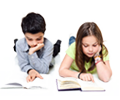Baasansuren, Bolormaa Adapted by: Mixter, Helen
Baby Jilu talks through his first year in the world, from when he is born to when he is a year old. he is born into a round world, with a round bed in a round home in Mongolia. His family comes to meet him, and they travel to their autumn quarters. Once snow begins to fall, Jilu's family moves on to their winter campground and soon celebrate Tsagaan Sar, meaning Spring will come again. In the spring, Jilu can ride on the camel saddle with his mother, and he will not have to wear boots again until after summer.

